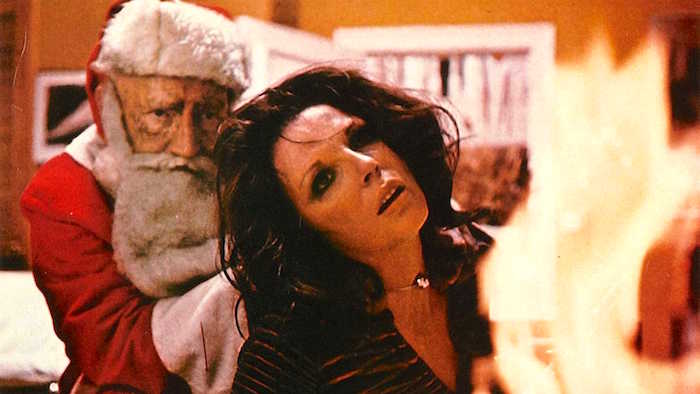TALES OF THE UNCANNY
 Wednesday, December 2, 2020 at 2:32PM
Wednesday, December 2, 2020 at 2:32PM
Featuring: Kier-La Janisse, David Gregory, Eli Roth, Joe Dante, Mark Hartley, Mick Garris, Ernest Dickerson, Joko Anwar, Ramsey Campbell, David DeCoteau, Kim Newman, Jovanka Vuckovic, Luigi Cozzi, Tom Savini, Jenn Wexler, Larry Fessenden, Richard Stanley, Brian Trenchard-Smith, Brian Yuzna, Gary Sherman, Rebekah McKendry and Peter Strickland.
Director: David Gregory.
AUSTRALIAN PREMIERE: Screening with NIGHT TRAIN TO TERROR 35th Anniversary presentation at Monster Fest from 1:30pm on Sunday, 6th December, Cinema Nova, Carlton, Melbourne.
Rating: ★ ★ ★ ★

Anthology films, those critically under-valued providers of thrills and chills for generations of genre fans, are afforded an appropriately passionate, often giddily infectious reappraisal in Tales of the Uncanny. Severin Films’ boss David Gregory, working with renowned horror academic Kier-La Janisse, have corralled over 60 exponents of cinema’s darkest artistry to recount and respect the greatest short-form film narratives in movie history. Refreshingly, the doco compiles two Best of... lists - for whole films and individual segments -in a gesture that will help new fans seek out the finest of the genre.
While even the best of anthology films suffer from the inevitable saggy segment (a common trait acknowledged by the filmmakers and their interviewees), no such dip in tone or quality infects Gregory’s buoyant love letter. Tales of the Uncanny tracks the portmanteau format from its origins in Germanic puppet theatre and the collected works of Poe and Lovecraft in publications such as Grahams and Weird Tales magazines through the very earliest days of filmmaking.
Anthologies played a key role in early European cinema, such as the German masterpieces Eerie Tales (Dir: Richard Oswald, 1919) and Waxwork (Dirs: Leo Birinsky and Paul Leni, 1924) and the great British work Dead of Night (1945), featuring director Alberto Cavalcanti’s classic segment ‘The Ventriliquist’s Dummy’ (with Michael Redgrave; pictured, below). Anthologies soon found favour within Hollywood’s star-driven studio system; director Julien Duvivier’s 1943 pic Flesh and Fantasy boasted the dream cast of Barbara Stanwyck, Edward G Robinson and Charles Boyer.

The obsessively-minded cavalcade of contributors - amongst them, filmmakers (Eli Roth, Joko Anwar, Brian Yuzna, Larry Fessenden, Jenn Wexler, Mattie Do); authors and academics (Kim Newman, Amanda Reyes, Maitland McDonagh); genre giants (Tom Savini, Roger Corman, Luigi Cozzi, Joe Dante, Greg Nicotero, David Del Valle); and, Antipodean talent (Mark Hartley, Brian Trenchard-Smith, Mark Savage) - recount seminal moments in the anthology classics of their formative film years. The coverage is exhaustive, but extra attention is paid to such landmark movies as Mario Bava’s Black Sabbath (1963); Masaki Kobayashi’s Kwaidan (1964); and, Histoires extraordinaires (1968; aka Spirits of the Dead), featuring segments by Louis Malle, Roger Vadim and Frederico Fellini.
Even at a relatively lean 103 minutes, Gregory and Janisse are able to fully profile U.K. outfit Amicus Productions, kings of Britain’s golden age of anthology films (Dr Terror’s House of Horrors, 1965; Torture Garden, 1967; The House That Dripped Blood, 1970; Tales from the Crypt, 1972 (pictured, top; with Joan Collins); From Beyond the Grave, 1974); highlight small-screen anthology horror, from the groundbreaking work of Dan Curtis (Trilogy of Terror, 1975; Dead of Night, 1977) to the resurgent anthology TV-series boom of the ‘80s (Amazing Stories, Tales from the Crypt, Freddy’s Nightmares); and, the classics of the modern era, both adored (Creepshow, 1982; Twilight Zone The Movie, 1984; V/H/S, 2012) and ignored (Cat’s Eye, 1985; From a Whisper to a Scream, 1987; Southbound, 2015).
Tales of the Uncanny has done its job if the viewer comes away with a list of films to re/watch, and it certainly achieves that. It also succeeds in painting the portmanteau genre as a form of film storytelling that needs to be more seriously addressed by both mainstream audiences and film historians. At their very best, anthology films offer the most unique of movie-going experiences and, with credit to David Gregory and Kier-La Janisse, ought now be examined more respectfully.
 Documentary,
Documentary,  Horror Film,
Horror Film,  Monster Fest,
Monster Fest,  anthology
anthology 

